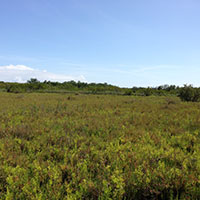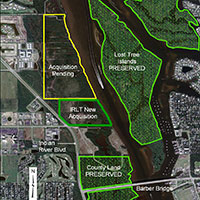 Another key piece of riverfront property bought by Land Trust
Another key piece of riverfront property bought by Land Trust
STORY
The Indian River Land Trust, after a year-long effort, has completed its purchase of a 56-acre piece of riverfront property that is a key component in its plan to preserve the natural shoreline of the lagoon north of the Barber Bridge.
“There are not many communities on the east coast of Florida where you can come over a causeway and see a green vista like the one we see looking north when driving from the island to the mainland,” says trust Executive Director Ken Grudens.
The Land Trust bought the property from Ryall Acquisitions Group LLC for the discounted price of $700,000. Ryall paid $2.5 million for the acreage in November 2006.
“We were able to buy it because a sympathetic landowner was willing to sell for less than fair market value,” says Grudens.
Ralph Monticello manages land acquisitions for the trust. He says a number of meetings were held with the landowner and the landowner’s agent over the past year during which he and a trust board member worked to build rapport and explain the trust’s goals.
“In negotiations of this type, we try and convey our environmental vision, our vision for the shoreline, and get buy-in from the seller,” Monticello says. “There was definitely an element of philanthropy in this transaction.”
One part of the trust’s vision is to protect the scenic beauty that stretches north along the mainland shore from Royal Palm Pointe to Grand Harbor.
Indian River County bought 125 acres of wetlands that flank the western base of the Barber Bridge in 1990 in preparation for bridge construction and county long-range planning chief Sasan Rohani says that land will never be developed.
“The whole reason for acquiring [extra land on the mainland shore] was for preservation, to keep it in its natural state,” he says.
“The county land anchors that whole corridor,” says Monticello. “Our goal is to preserve the rest of the view-scape.”
 The 56-acre parcel starts half a mile north of the bridge and extends a third of a mile along the shore. It abuts a 150-acre environmental mitigation property that is the trust’s next target.
The 56-acre parcel starts half a mile north of the bridge and extends a third of a mile along the shore. It abuts a 150-acre environmental mitigation property that is the trust’s next target.
“We are working toward acquiring and managing the land bank property,” says Grudens. “Eventually we hope to protect the entire shoreline.”
The newly-acquired property has more than just scenic value.
“There are pristine salt marshes in there, which is a resource that has almost vanished from the shores of the Indian River Lagoon,” says Monticello.
Keeping the land in its natural state also helps protect the estuary from polluted runoff that is a main cause of seagrass loss, manatee deaths, dolphin disease and other problems plaguing the lagoon.
“The property runs from the shoreline to Indian River Boulevard,” says trust Director of Development Ann Taylor. “That makes it potentially very developable.”
The trust is working with Vero Beach environmental consultant David Cox and the U.S. Fish and Wildlife Service to develop a management plan for the property.
“It probably lends itself to some type of public access because of the upland trials that are already in there,” says Gruden.
The acquisition follows a series of earlier conservation accomplishments by the trust, which was founded in 1990 to help save McKee Botanical Gardens, a 10-year, $10-million project.
Following that successful endeavor, the trust was instrumental in preserving 2,000 acres of agricultural land from development.
In 2004, it led the effort to pass a $50-million land and water protection bond issue referendum that was approved by 67 percent of voters, enabling the county to buy a number of properties for conservation.
With land prices skyrocketing, the county rushed to buy property before it became still more expensive and ended up spending the $50 million at or near the peak of the boom.
That miscalculation on the part of the county magnifies the importance of the trust’s efforts.
“The land trust has taken up the cause the county had taken up when it had funding through the bond referendum,” says county Environmental Planning Chief Roland DeBlois. “We have pretty much run out of money and the Land Trust has become the primary agency or non-profit out there buying and conserving land these days. They are definitely filling an important need.”
“In January 2009, our board recognized we had a historic opportunity to protect the lagoon and habitat near it,” says Grudens. “Because of the real estate downturn and failed developments along the water, extraordinary pieces of land were potentially available for conservation that would have been out of reach before.”
Since shifting its focus to protecting estuarine acreage four years ago, the trust has raised more than $8 million and permanently preserved seven miles of shoreline and nearly 700 acres of environmentally sensitive property critical to the wellbeing of the lagoon.
“We really support what they are doing, getting private money to purchase conservation lands,” says Richard Baker, president of the Pelican Island Audubon Society.“
“They are doing a wonderful job of conserving properties that might otherwise be developed,” says Warren Falls, managing director of ORCA – the Ocean Research and Conservation Association. “I hope they keep doing what they are doing.”








